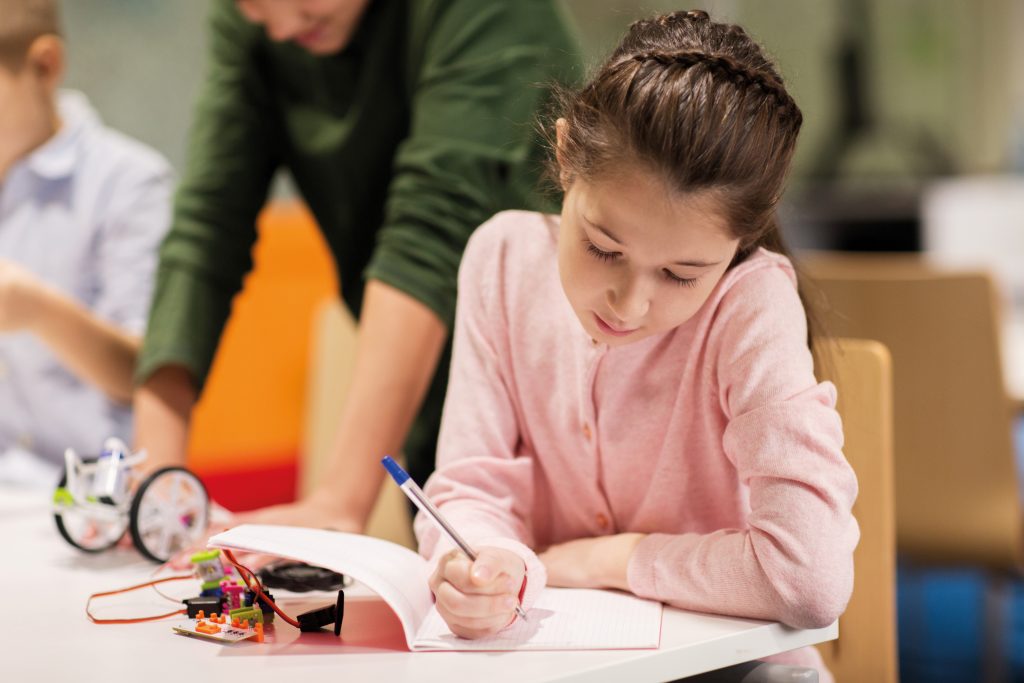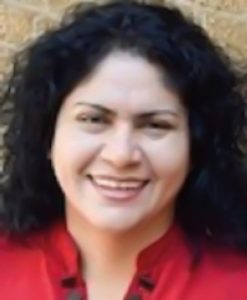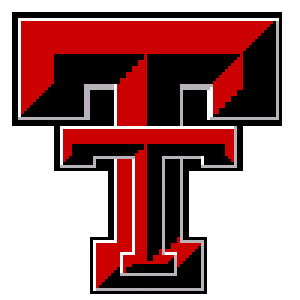Dr Zenaida Aguirre Muñoz | Dr Magdalena Pando | Dr Michelle Pantoya – Fostering Enthusiasm for Engineering from an Early Age
As engineering and other scientific disciplines play an increasingly prominent role in our society, it is crucial to introduce children to these subjects from an early age, as this could encourage them to pursue careers in these fields in the future. With this in mind, Dr Zenaida Aguirre Muñoz, Dr Magdalena Pando, and Dr Michelle Pantoya have been conducting research investigating the effectiveness of teaching practices and methods aimed at introducing young children to engineering and science.
Introducing STEM to Young Children
Technology is a central part of our daily lives, from early inventions such as doorknobs and pencils to modern advancements including smartphones and tablets. Such technologies make our life easier by solving a problem or fulfilling a need. Engineers design technologies using an understanding of math and science. To sustain the current speed at which new technology is developed, and to address societal challenges such as medical needs and energy demands, it is crucial that we prepare the next generation for careers in engineering.
To this end, governments worldwide have been calling for meaningful initiatives and academic programs aimed at introducing younger generations to science, technology, engineering and mathematics (STEM). In 2012, the National Research Council published the Next Generation Science Standards, which specifically encouraged schools to integrate engineering curricula in K-12 education.
Despite the call for more academic programs designed to teach engineering-related skills to young children, the vast majority of engineering education initiatives developed so far have targeted secondary school and college-level students. Introducing engineering to kindergarten or primary school children, however, could have significant advantages, as it could give them a chance to cultivate an interest while they are still young, potentially encouraging them to pursue a career in engineering later in life.
Teaching STEM-related topics to young children from varied backgrounds could also help increase diversity in the engineering workforce, encouraging more girls and children from underrepresented minorities to become engineers in the future. Engineers from diverse backgrounds can provide unique perspectives on the design of future technologies that positively impact our way of life.
One of the reasons why programs aimed at teaching engineering-related skills to very young children are still scarce is that effective engineering-focused teaching strategies are limited. Children between the ages of 3 and 7 often have short attention spans, which can make their learning of more advanced concepts particularly difficult.
Dr Aguirre-Muñoz, Dr Pando and Dr Pantoya, three researchers working at the University of Houston, New Mexico State University and Texas Tech University, respectively, have been investigating different teaching practices designed to introduce children to engineering from an early age. Their work explores both the challenges and potential associated with these practices, while also assessing their possible impact on the engineering field at large.

Teaching Practices
The overall goal of the team’s research is to promote STEM learning among young children, by introducing and evaluating engineering-centred literacy practices that could be applied in kindergarten and elementary schools. Their research was supported by grants from the National Science Foundation.
Because very few STEM-education programs have targeted children from ages 3 to 7 years, the researchers set out to identify existing engineering-related materials and integrate them into curricula for these particular age groups, adapting them to ensure that they were age appropriate.
The materials and engineering-centred teaching practices they devised are based on the intentional use of a variety of tools, ranging from storybooks to technological devices, such as iPads. They then tested these teaching practices in real classrooms, evaluating their impact on children’s attitudes towards engineering, on their identity development, and on their understanding of STEM-related content.
The researchers set out to explore two key research questions. Firstly, they wished to assess the impact of the engineering-related teaching practices on STEM learning, knowledge of technology, and identity development of children from kindergarten to the second grade. Secondly, they investigated whether children who were exposed to a combination of these practices learned more than those who were only exposed to some of them.
Developing Children’s STEM Identity
One study specifically evaluated whether engineering-related curricula could aid the development of an engineering identity in early childhood.
The strategy they evaluated involved the use of storybooks that present simple STEM-related concepts, combined with interactive discussions, and a creative drawing activity. In their study, the researchers specifically used a book called ‘Engineering Elephants’ to introduce the concept of technology and the work of engineers to young children in an engaging and age-appropriate way.
Instruction for the children participating in the study started with their teacher or supervisor asking them the simple question: ‘What do engineers do?’ The children’s answers were then written on a board, initiating a discussion about technology that lasted several minutes. This discussion was followed by the teacher reading ‘Engineering Elephants’ aloud, while reinforcing concepts presented in the book, including technology, science, and math. The story ends with a question: ‘When you grow up to be an engineer, what new things will you create?’
The children’s answers to this question were compared to their initial responses about technology and the nature of engineering, sparking further discussion on the topic. Finally, the children were asked to sketch or draw something that they would create as engineers, solidifying their understanding of technology and design that incorporates math and science thinking.
The researchers were able to introduce this simple storybook-based lesson into several different classrooms with students aged between 3 and 7 years. Overall, the teaching practice was found to encourage many children to develop an engineering identity, potentially seeing themselves as becoming engineers in the future.

Children’s Responses to Engineering Activities
Another study investigated how kindergarten students responded to literacy-enriched engineering activities, both in terms of their engagement and understanding of the curricular material.
The researchers trained teachers working at two different kindergarten schools in Texas to deliver the lesson centred around the ‘Engineering Elephants’ book to young students, while also using engineering challenges and investigations of materials designed to teach engineering-related content to children. This curricular material was delivered at the two schools, which had a total enrollment of approximately 650 children from various cultural backgrounds.
The research team recorded the children’s engagement and their participation in discussions, to assess the impact of the simple classroom activities devised by the researchers. Overall, the data collected indicated that the children found the engineering-related lessons highly engaging and their understanding of the material increased throughout the course of the intervention.
Age-appropriate Language Tools
The team also carried out a study exploring the use of language tools to deliver engineering-based curricula to young children. In particular, the researchers wanted to investigate the degree to which children who were not proficient in English learned language through science and engineering classroom discussion and activities.
This study involved children with a Latinx cultural background from K-2nd grade. The children took part in a series of activities modified for age appropriateness based on a unit from a specific curriculum called Engineering is Elementary (EiE). The EiE curriculum was designed to increase the technological literacy of young children through the use of narrative texts and other activities that involve problem-solving, collaboration, and communication.
The researchers tested the children’s learning of science and engineering-related practices and vocabulary before and after the intervention. They found that the young English language learners’ use of linguistic structures to paraphrase, elaborate on specific ideas, or challenge these ideas greatly improved over time. Overall, the incorporation of engineering-based academic conversations promoted language development in ways that supported meaningful participation in science and engineering activities.
Initial Outcomes
Further research by the team aimed to evaluate the impact of a teaching approach called Engineering Everything, which included Cheers for Engineers, an interactive iPad game for children they developed.
Engineering Everything is an instructional approach designed to increase young children’s engagement in and understanding of engineering-related topics, while also promoting their development of an engineering identity. Cheers for Engineers, on the other hand, is an engaging and interactive iPad game that exposes children to a variety of engineering practices using age-appropriate language and visual aids. It is designed to reinforce engineering-based problem solving when considering materials for specific engineering challenges.
The researchers implemented these two different teaching activities in nine different classrooms. A total of 349 participated in this study: 120 kindergarten, 107 first grade, and 122 second grade children. Overall, the team found that the Engineering Everything intervention consistently led to an increase in the children’s understanding of technology and science learning. In addition, those exposed to this teaching practice seemed to find it easier to see themselves as engineers in the future.
The Cheers for Engineers game uniquely strengthened the first and second grade children’s learning and sense of self, yet it typically did not uniquely improve kindergarten children’s knowledge of technology above the improvements of the components of the intervention (literacy and language tools).
Towards a Diverse Engineering Workforce
Overall, the results of the team’s research highlight the promise of introducing engineering-related curricula and teaching practices in kindergarten and elementary school classrooms. In particular, the researchers found that simple STEM-based activities, including classroom discussions, storybook readings, and creative drawing tasks enhanced young children’s knowledge of technology and engineering as a whole, while also helping them develop an engineering identity.
In the future, their findings could inspire more educators to introduce similar teaching practices in kindergartens and elementary schools, sparking greater interest in engineering among children from an early age. These practices could encourage children from diverse backgrounds to develop an engineering identity early on in life and to ultimately aspire towards engineering-related careers, potentially leading to a more diverse STEM workforce.
Reference
https://doi.org/10.33548/SCIENTIA506
Meet the researchers

Dr Zenaida Aguirre-Muñoz
Department of Psychological, Health, and Learning Sciences
University of Houston
Houston, TX
USA
Dr Aguirre-Muñoz holds a PhD in Educational Psychology, a BA in Psychology and a BA in Spanish from the University of California, Los Angeles. She is currently an Associate Professor in the Department of Psychological, Health, and Learning Sciences at the University of Houston. Over the course of her career, she has carried out extensive research related to educational psychology and teacher education and learning. Her key research interests include multilingualism, STEM teaching and learning, increasing student engagement and achievement, teaching diverse populations of students, and literacy development for students learning English.
E: zaguirre-munoz@uh.edu
W: http://voyager.coe.uh.edu/dir/faculty_template.cfm?id=822

Dr Magdalena Pando
School of Teacher Preparation, Administration and Leadership
New Mexico State University
Las Cruces, NM
USA
Dr Pando holds a PhD in Curriculum & Instruction, as well as an MA and BA in Spanish, from Texas Tech University. She is currently an Assistant Professor of Curriculum & Instruction at the School of Teacher Preparation, Leadership and Administration at New Mexico State University. Over her career, Dr Pando has conducted a number of research studies related to education and curriculum development. Her main research interests include STEM education, bilingual education and initiatives designed to enhance language learning experiences.
E: mpando@nmsu.edu
W: https://tpal.nmsu.edu/faculty/dr-magdalena-pando/

Dr Michelle L. Pantoya
Department of Mechanical Engineering
Texas Tech University
Lubbock, TX
USA
Dr Pantoya holds a PhD and an MS in Mechanical Engineering, as well as a BS in Aeronautical Engineering from the University of California, Davis. She is the J. W. Wright Regents Endowed Chair Professor at Texas Tech University. Over the course of her career, Dr Pantoya has conducted extensive research focusing on a variety of topics rooted in engineering, as well as in other scientific disciplines.
E: michelle.pantoya@ttu.edu
W: https://www.depts.ttu.edu/me/faculty/michelle_pantoya/index.php
FUNDING
US National Science Foundation:
DRL-1249874
REE-1463820
REE-1836081



Creative Commons Licence
(CC BY 4.0)
This work is licensed under a Creative Commons Attribution 4.0 International License. 
What does this mean?
Share: You can copy and redistribute the material in any medium or format
Adapt: You can change, and build upon the material for any purpose, even commercially.
Credit: You must give appropriate credit, provide a link to the license, and indicate if changes were made.
More articles you may like
Grandmothers: Innovation Through Tradition
Grandmother Project – Change through Culture (GMP) is an organisation dedicated to documenting the role of grandmothers and demonstrating the effectiveness of grandmother-inclusive strategies in improving the health and well-being of women, children, and adolescents. GMP’s groundbreaking work challenges conventional wisdom to transform community-based interventions in Africa and beyond, harnessing a powerful but often overlooked resource: the wisdom and influence of grandmothers.
Dr Robert Larkin | Cultivating Change to Improve Soil Health and Increase Potato Yield
Environmental quality and food production are facing the pressing challenges of climate change and global population growth. Dr Robert Larkin from the United States Department of Agriculture-Agricultural Research Service (USDA-ARS) and a team of plant scientists developed and tested a range of crop management systems to help overcome these compounding challenges. Their work is improving soil health and increasing the yield of potato crops, contributing to the future food security of nations.
Professor Giorgio Buttazzo | Artificial Intelligence and a Crossroads for Humanity
Where do we stand with artificial intelligence? Might machines take over our jobs? Can machines become conscious? Might we be harmed by robots? What is the future of humanity? Professor Giorgio Buttazzo of Scuola Superiore Sant’Anna is an expert in artificial intelligence and neural networks. In a recent publication, he provides considered insights into some of the most pressing questions surrounding artificial intelligence and humanity.
Dr Ralf Adam | New Technologies Shaping the Future of Oral Hygiene
Understanding the efficiency of various toothbrush technologies is essential for achieving optimal oral health. Dr Ralf Adam, who leads a dedicated team at Procter & Gamble in Germany, is keen to investigate the complexities of these technologies. His team have provided new insights into the best toothbrush types for plaque removal and the maintenance of gum health. By highlighting the importance of informed oral care decisions and ongoing investigations, this vital research works towards ensuring everyone can achieve a brighter, healthier smile.




